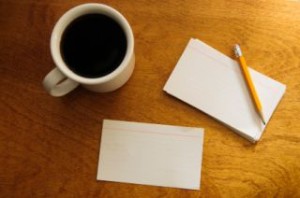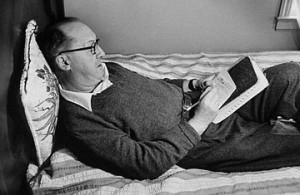Index Cards Are Sexy

I’d like to share some thoughts about index cards.
My new writing, with the exception of blog entries of course, is happening on index cards. The fact that this is how my hero, Vladimir Nabokov, wrote all of his first drafts is purely coincidental.
Over the years, I’ve used index cards as ways of encapsulating scenes in stories or novels by writing a simple “slug” on each one, like this one from my first Dakota Stevens novel: “EXT. — Walk to W. Village diner in blizzard — NIGHT.” The purpose of this was to allow myself to shuffle the cards and get different views of potential scene orders, and to be able to see at a glance how many interior and exterior scenes there were. I happen to like a lot of variety of scene locations in my work, and this non-linear approach was one way to achieve scene variety.
However a few days ago I went to my salvaged library card catalog (in which I store my pencils by brand, along with other supplies) to get a sharpener and I saw a hefty stack of index cards just sitting there.

For the past couple of months, when I’ve sat down to write and faced the infinitely blank screen, the unnervingly white typing paper, or the falsely humble page of looseleaf, I’ve been overwhelmed by the sense of futility and hugeness of writing yet another (potentially) big work. So when I saw the index cards, and I thought about how well they’d worked for Nabokov, I decided this time to give them a try for my own first draft.
Index cards have many advantages over the other writing methods I mentioned, but let me share a few of my own observations about them:
• When you put one in front of you, its small size (3″x5″) gives you the feeling, “I can take this little bastard.” It’s small, so you can fill it easily, and the faster you fill them, the faster you develop momentum. Very quickly you can have a pile of 25, 50, 100 cards, which feels great and encourages you to keep going.
• You can write whole scenes, snatches of dialogue, smells, internal monologues, descriptions of places—anything you want—on each card, and you can do it all out of order. Working nonlinearly, I’ve noticed, frees up so much more material in you because you don’t feel like you have to have the next scene, and the next, and the next all lined up ahead of time. You just start writing about what you’ve got, shuffle up the cards, and when you sit down again, write what you’ve got.
• They’re cheap and easily organized later on, whether on display boards or index card “bleachers,” for transcription and editing.
• For those of you who respond to the visual and aesthetic qualities of your writing media, they’re cute and available in multiple colors in case you want to color-code them.
• You can put a stack of 25 of them in an envelope, along with a couple of pencils and a small block sharpener, and put the envelope in your coat pocket, and voilà!—instant, pocket-sized, portable writing center.
I could go on and on about the virtues of index cards, but you have to use the writing process that works for you. Maybe they’ll work for you, maybe they won’t; I just wanted to open your eyes to this extant low-tech writing method and its possibilities.
Comments (4)